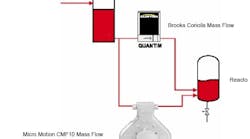Catalysts are the driving force behind advancements in the chemical industry. And like many other chemical manufacturers, Dow Chemical is continuously developing new catalysts to improve product quality and maintain a competitive price position. The company recently developed a reactive catalyst for use in one of its production facilities. Indications were that this new catalyst could save the company millions of euros once it reached full-scale production. The challenge was transferring the recipe using this new reactive catalyst from the laboratory to the pilot plant and, ultimately, to the production level.
Scale-up issues
Reactive catalysts are injected into a chemical process through a flow meter. It’s imperative that the precise amount of catalyst be injected into the reactor; too much or too little catalyst threatens batch quality. This crucial point is magnified when delivering a reactive catalyst because less is required to stimulate the desired chemical reaction. Hence, a highly accurate flow meter is necessary for precise injection. Process engineers in the chemical industry prefer Coriolis meters because they measure direct mass, which delivers highly accurate and repeatable results.
Injecting a smaller amount of catalyst is not a problem at the production level because Coriolis meters are widely used at these higher flow rates. But until recently there was no Coriolis meter capable of measuring and controlling the extremely low flows necessary to test reactive catalysts in laboratory and pilot plant processes. This caused scale-up issues.
A process could be perfected on a smaller scale in the laboratory or pilot plant but lose valuable time during start-up at the production level because the flow meter systems weren’t operating on the same principles of measurement. Process engineers spent days, even weeks, adjusting the catalyst injection process at higher flow rates.
Instrumentation experts at the Dow Terneuzen site in the Netherlands have solved this scale-up issue using the Quantim Coriolis mass flow controller from Brooks Instrument.
Finding the right meter
Terneuzen is Dow’s largest production site outside the United States. It features 26 production units, one of which produces a delicate product. A section of this unit is dedicated to testing catalysts that require very accurate injection. When a newly developed catalyst proves valuable in the laboratory, it is then tested at a pilot plant to minimize the risk of product loss. Biesheuvel and I, instrumentation specialists at Dow Benelux, were in charge of taking this new reactive catalyst from the laboratory to pilot plant testing. If all went well, our efforts would result in modification of the specific production unit.
We were mindful of several factors while searching for a flow meter for the process:
- capability of handling flow rate for catalyst injection in the range of 20 to 200 g/hr;
- accuracy of reading at 0.5%, one half the industry standard;
- high accuracy mass flow measurement despite pressure drops due to increasing flow; and
- no alteration or influence on the physical properties of the catalyst. The slurry had small solid particles and a viscosity slightly greater than water. If these particles were damaged during any part of the process the effectiveness of the catalyst would be greatly reduced.
The Quantim Coriolis mass flow meter satisfied all the criteria. In addition to meeting our needs Quantim operated on the Coriolis principle and solved our issues with scale-up. It was now possible for all flow meter systems in each stage of scale-up to operate on the same principle of measurement.
Quantim was engineered by Brooks to solve specific process challenges for this type of critical application in which traditional inferred measurement technologies aren’t adequate. It delivers liquid flow accuracy of better than 0.5% across a wide range of operating conditions and fluids without any correction factors. This precision is especially important in critical environments where micrograms of material often make the difference between profit and loss. And because Quantim measures mass flow directly, rather than by inferred properties and calibrations, it can handle most liquids with great precision regardless of variations in viscosity, temperature or flow rate.
How the flow metering system works
The operating range of the catalyst injection process was 1-1000 g/hr with a line size of 1/8 in. Due to the physical properties of the catalyst, the process was required to overcome one disadvantage: high pressure drop. The pressure drop over the Quantim meter was already 3 bar at 100 g/hr. So, we decided to use the Quantim meter for the lowest part from 20-100 g/hr and use a Micro Motion CMF10 Coriolis meter for the range from 100-200 g/hr. We also designed the process so that the Quantim meter double-checked the CMF at the lower flow range. Both meters were installed in series with an automatically controlled bypass and solenoid valve over the Quantim meter for flow rates above 100 g/hr.
Flows of this magnitude are just drops of fluid, and any variation has a major impact on the results of the pilot test. To make sure that the system worked, a small test was performed. The catalyst was pumped through the meter and collected on a scale as it came out the other end. The results were very good, even at the lowest flow rates (Figures 1 and 2).
The results
In 2002, Dow built a pilot plant system with a 50-liter reactor to fully test the process we had engineered. The system has been running since then at maximum capacity and the results have been excellent. Using the Quantim Coriolis mass flow meter has decreased the total testing time by several months.
The first full-scale production reactor to be modified for use of the new catalyst was completed in the first part of 2004. The scale-up of the 60-m3 reactor was validated on schedule. This reactor has been running since 2004. Additional information can be found on Quantim at the Brooks Instrument website (www.brooksinstrument.com).
Kees Kaijser is Senior Instrumentation engineer for DOW Terneuzen, the Netherlands, E-mail him at [email protected].
